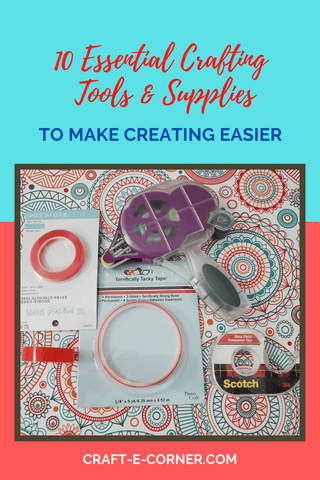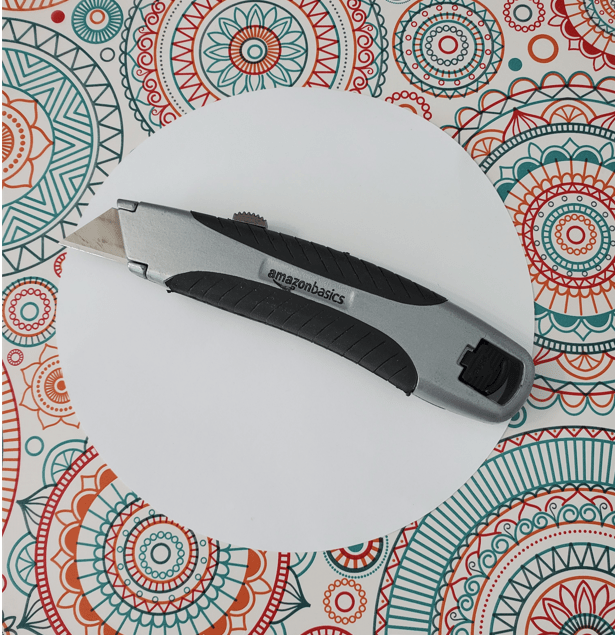On Orders $49+
On Orders $49+

Cricut has many wonderful tools and crafting consumables for use with their machines. However, I have found quite a few other items to be essential for crafting with my Cricut and for other projects as well. For any Cricut newbies out there, I thought I would share some of my favorite general crafting tools.
If you are interested in actual Cricut tools and supplies, feel free to view this post, which shows 5 basic tools: 5 Cricut Tools for Beginners.
Here is another post that showcases 10 different Cricut tools: Cricut Tools for Beginners.
Okay, moving on now to my 10 favorite crafting tools and supplies.

SECTION ONE
The first five items are ones that I use more often than any others.
1. BOX CUTTER

This comes in handy so often, especially when opening boxes of Cricut infusible Ink or Smart Materials. I also use it to open packs of scrapbooking paper or cardstock and for other craft supplies and blanks I purchase. The cardstock packs have those little tape circles on the edges that can be hard to get off. I found that if I slice the tape along the edge of the front and back covers of the paper pack, I can just remove a thin piece of it, and the covers don’t get that sticky spot from the tape residue.
2. PAINTER'S TAPE

I can’t even remember what I initially bought this for, but I use it for just about everything that I am creating. Sometimes I tape things onto my cutting mat, if I need to make sure the material on the mat doesn’t move. I most often use it to create placement guides on projects to keep everything even. I use it so often that I keep a roll of it either on or near my work station at all times.
3. RULERS

I use a ruler all the time for measuring, not only for cutting items, but for placement as well. While I often use Cricut’s Portable Paper Trimmer to cut vinyl or paper, I use a regular ruler just as often. Sometimes I have leftover bits of vinyl I need to measure to see if they can be used for a small project.
I also use a flexible measuring tape that is normally used for sewing. This can be rolled up and does not take up much space. It is really handy for measuring anything over 12 inches long. If I have some kind of large sign I need to measure, this works great for that.
4. SCISSORS

While the Cricut scissors work great for small, precise cutting, I use regular shears all the time. I could be cutting cardstock or trimming around vinyl for easier handling when applying it to my blank. Large pieces of vinyl can easily be cut with scissors because of the grid lines on the vinyl backing.
5. PEN AND PENCIL

I often use a pen or pencil to make markings on something I am planning to cut. I also find it useful to write notes for myself while working on a project. It often takes me a while to select a font in Design Space, so I will write down specific ones I like to help narrow down my choices. I also write notes about new procedures I learn or tips I come up with while doing a project. Then I can refer to them later for other projects and not have to "reinvent the wheel."
SECTION TWO
Here are some more items I use almost as frequently. They won’t be used for every project but are used often enough to keep them on hand for when I do need them.
6. PARCHMENT PAPER / BUTCHER PAPER / FREEZER PAPER

These items are commonly used when applying iron-on vinyl (HTV) or infusible ink to blanks. I use parchment paper so often that I purchased a package of 100 sheets in a flat box. These are usually used for cooking but work great for crafts as well. If the sheet is too large, I just cut it smaller for my needs. By using these sheets, I don’t have to cut pieces off of a roll and try to uncurl them.
7. CARDSTOCK

Not only is cardstock used for many craft projects, it has quite a few other uses. I use it to create patterns or templates and also to protect my Easy Press mat when I am applying infusible ink to a coaster or refrigerator magnet. I just place a piece underneath the blank. Because I usually cut my infusible ink a bit larger than my blank to make sure it gets full coverage, a bit of ink could get on the mat.
Another use for cardstock is to add extra thickness to paper. Sometimes I want a particular pattern or color of cardstock that is not available. If I find scrapbook paper I like, I just glue it to a sheet of cardstock to make it thicker and then proceed with my project. I have done this for bookmarks and am currently working on a faux picture frame where this became useful.
I use cardstock so often that I purchased a whole ream of it in white, which has turned out to be quite convenient. You could use any color of cardstock, but I chose white because otherwise I would feel that I was wasting something pretty.
8. GLUE / HOT GLUE / GLUE DOTS

Glue is one of those things that almost everyone uses. The type I choose to use for each project depends on what materials I am working with. Craft glues are available specifically for paper and other mediums. There are so many varieties. I even use glue sticks on occasion.
Glue dots are another option, and they come in different sizes that work well for attaching small pieces of material together. It is a lot easier to control where these are placed, whereas liquid glue can be messy and get on spots where you don’t want it.
Hot glue with a glue gun is another option that works great for attaching large items made with heavier materials, such as wood or plastic, etc. There are so many options for glue. It is ideal to have a variety of types on hand for any project you may decide to do.
9. TAPE

I use a lot of two-sided tape, and it is fantastic for crafting. I use it often for paper or cardstock projects. I often avoid using glue, as some will cause a bubbling effect on the paper, if I use too much, and I do not want that with my projects. Double-sided tape is a good fix for that problem, and it is quite permanent. This is also good for affixing photos to other materials. There will not be any danger of damage to the photo when using two-sided tape.
The red tacky tape can be a bit pricey if you use a lot of it, but it comes in different widths and is very strong, so I like to use it when it's important to have a strong, permanent grip. The red part is the liner that you pull off after applying the tape to one side of your project, so the actual sticky tape is clear. You can get this tape with a clear liner, but I prefer the red, as it is easier to see for placement purposes and for pulling it off the sticky tape.
Another favorite is the GlueGlider Pro. It provides a quick and easy way to apply a line of thin, two-sided tape squares to larger projects. I have found this tape to be very functional and permanent as well.
I have also been known to use good old-fashioned Scotch tape when that will suffice.
10. LINT ROLLER

If you are going to do any type of iron-on or infusible ink projects, a lint roller is a must. It works great for cleaning off your blanks to create a clean surface to apply your designs to, whether it be a t-shirt, a hat, a mug, a coaster, or anything else you might decorate via heat transfer. You can also use it on your blanks before applying adhesive vinyl. I keep a lint roller right on my desk/work area.
If you would like to see how to apply Iron-On Vinyl to a shirt, check out this post: Beginner Cricut Iron-On Project - Grandma's T-shirt.
Well, there you have it. My 10 favorite general crafting tools and supplies. There are many other supplies and materials I use, but these are the ones I use over and over and can't do without. What are your favorite crafting tools and supplies for creating with your Cricut?
I have a well stocked craft room, so I have everything I need. Except maybe more craft supplies.
Leslie
Leave a comment